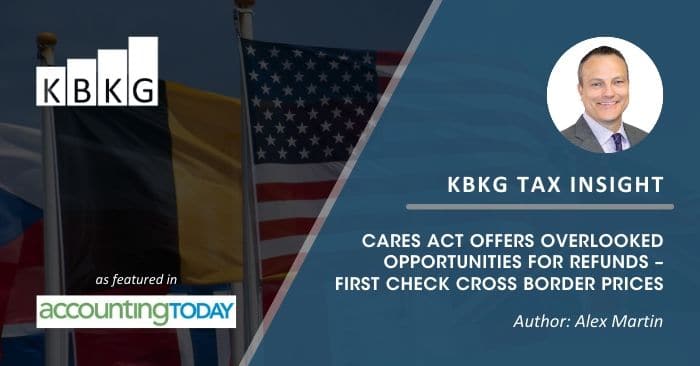As featured in Accounting Today
Some multinational companies can generate additional carryback tax loss relief through transfer pricing planning.
Under the Coronavirus Aid, Relief, and Economic Security (CARES) Act, US corporations can now elect to carryback losses incurred in 2020 for a five-year period (2015 to 2019).[1] The Act was implemented to provide badly-needed cashflow for companies hard-hit by Coronavirus shutdowns. Recently profitable companies could apply for refunds against federal income taxes paid in prior years.
KBKG Insight:
From a practical perspective, US tax NOLs are more valuable after the CARES Act for many companies; cash refunds for taxes already paid are worth more than utilizing tax losses against profits in future years.
While many multinational companies are expecting to incur global losses during 2020, centralizing these losses in the US may generate additional refunds through transfer pricing planning. Realizing refunds is highly dependent on several tax variables such as a US company’s foreign tax credit position, Section 965 repatriation tax, GILTI Tax, and a host of other factors. However, a company that paid significant income taxes in recent years may find revisiting transfer prices worthwhile for carryback refunds.
Why does the CARES Act create new opportunities for carryback refunds?
Before the CARES Act, the Tax Cuts and Jobs Act (TCJA) and other legislation severely constrained the ability to use net operating losses to lower tax liabilities. TCJA restricted carrybacks of NOLs and limited carryforwards to 80% of taxable income. After the CARES Act, corporations incurring tax losses during 2020 in the US can now elect to carryback NOLs as far back as 2015.
The cash refund savings can be as high as 35 percent when electing to apply 2020 NOLs to taxes paid during 2015, 2016, and 2017 (before tax reform). Since US federal tax rates were reduced after tax reform, the federal tax refund could be as high as 21 percent for 2018 and 2019. For all years, there are complicated provisions that could limit the savings from carryback losses.
A company that can optimize its tax NOL position can carryback losses for taxes paid in recent years.
How does transfer pricing during a pandemic affect tax NOLs and carryback refunds?
The transfer pricing of goods, services, and royalties among related companies drive losses or profits by country, even during a pandemic. Given the economic upheaval from COVID-19, changes to transfer prices may be warranted. For example:
- A “cost-plus” policy may create excess profits for suppliers selling to related companies.
- Royalty rates charged to subsidiaries may be too high under current market conditions; and
- Parent company service charges may be overallocated to subsidiaries.
Management adopting a wait-and-see approach after year-end may find some locations paying large tax bills while other subsidiaries are facing higher risks of tax audits.
So . . . how much of a refund for a 2020 loss generated now?
For companies anticipating losses during 2020, a simplified numerical example may help illustrate the potential benefits of centralizing losses in 2020 through transfer pricing corrections.
In the “Present State,” a historically profitable US company has $10m of intercompany transactions with a foreign subsidiary. During 2020, the parent expects to split companywide losses of $1m with the foreign subsidiary on a 50/50 basis. Under the CARES Act, the US parent company can carryback losses to 2015 for a $175,000 refund ($500,000 x 35%).

Under the “Future State,” the company centralizes the losses by reducing the transfer price of intercompany transactions from $10m to $9.5m. Therefore, the US company now has $1.0 million in losses, and the foreign subsidiary would be breakeven. Since the parent company can carryback the entire $1,000,000 of carryback losses to 2015, the US company would receive a $350,000 refund – an increase of $175,000.
What is the catch?
Unfortunately, decisions to centralize tax losses require an assessment of several complicated internal and external factors. Some variables include:
- What is the projected companywide tax loss for 2020?
- What transfer pricing adjustments can be made during 2020?
- How much income was taxed at a 35% rate (2015-2017)?
- How much income was taxed at a 21% rate (2018-2019)?
- Would a company lose foreign tax credits after an NOL is carried back?
- How much repatriation tax is due under section 965 (2018-2019)?
- Would a carryback NOL affect FDII deductions, GILTI liability, or application of the BEAT tax (2018-2019)?
- Not to mention other opportunities and considerations such as accelerating deductions (cost segregation and R&D), AMT, interest expense. . .
In summary, companies operating internationally certainly have more complications than US-only companies when considering whether to carry back tax NOLs. However, the benefits of transfer pricing corrections while managing other tax planning issues can be substantial.
KBKG Insight:
For most corporations that did pay substantial US taxes from 2015 to 2017, carrying back losses incurred during 2020 is likely to be an easier decision. The company would receive a refund of 35 percent on losses carried back, subject to issues such as foreign tax credits. The alternative to the carryback would be losses offsetting future income at a 21 percent, post-tax reform, rate. Applying carryback losses to 2018 and 2019 at the 21 percent rate is a more difficult decision in addition to more complications from the many transition issues implemented.
Bottom Line:
The opportunity to carryback losses under the CARES Act is welcome cashflow for companies doing well up until the pandemic. While multinationals face many more complications in applying the CARES Act, these companies do have some control over where losses are incurred during 2020. Planning can help management realize greater refunds from the CARES Act, which ultimately may drive whether companies survive after the pandemic.
Where can I go for additional questions?
If companies or CPAs have questions about Transfer Pricing, KBKG’s Principal and Practice leader, Alex Martin, is here to assist. » Schedule a call now
KBKG also has many resources on our website to help you answer any other questions not listed here. » Learn about Transfer Pricing
Register for our Transfer Pricing after Tax Reform and COVID Webinar
For additional information, join us for a free webinar on transfer pricing presented by Alex Martin.
Author: Alex Martin
[1] While losses incurred in 2018 and 2019 can also be carried back five years, this article addresses 2020 current year opportunities.
About the Author
 Alex Martin – Principal
Alex Martin – Principal
Midwest
Alex Martin is Principal and Transfer Pricing Practice leader at KBKG, operating from Michigan. He has 22 years of full-time transfer pricing experience working in Washington, D.C.; Melbourne, Australia; and Detroit, Michigan over the course of his career. Alex has assisted companies in many industries addressing transfer pricing issues on a US and global basis. » Full Bio



